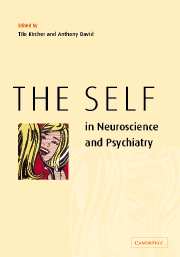Book contents
- Frontmatter
- Contents
- List of contributors
- Introduction: the self and neuroscience
- Part I Conceptual background
- 1 The self and psychiatry: a conceptual history
- 2 The self in philosophy, neuroscience and psychiatry: an epistemic approach
- 3 Phenomenology of self
- 4 Language and self-consciousness: modes of self-presentation in language structure
- Part II Cognitive and neurosciences
- References
4 - Language and self-consciousness: modes of self-presentation in language structure
from Part I - Conceptual background
Published online by Cambridge University Press: 18 December 2009
- Frontmatter
- Contents
- List of contributors
- Introduction: the self and neuroscience
- Part I Conceptual background
- 1 The self and psychiatry: a conceptual history
- 2 The self in philosophy, neuroscience and psychiatry: an epistemic approach
- 3 Phenomenology of self
- 4 Language and self-consciousness: modes of self-presentation in language structure
- Part II Cognitive and neurosciences
- References
Summary
Abstract
One of the most prominent diagnostic symptoms of schizophrenia amounts to hearing an inner voice that is not attributed to the self. A proper explanation of the nature of the schizophrenic condition requires, correspondingly, an orientation of the relations between language faculty and self-consciousness – both in norm and in pathology. The aim of this chapter is to offer an overview of some basic aspects of this relationship. The presentation will be by necessity brief and selective, as the problem area is wide and there is virtually no literature explicitly dealing with it from a linguistic perspective.
In the first part of the chapter the point is made that speech, inner speech in particular, serves as the subtlest (and, in a sense, the ultimate) vehicle of online maintained self-awareness. The experience of voice here and now provides the self with the means of making itself ‘visible’ during language performance. In inner speech the loop between perception cum motor behaviour cum perception is the shortest one and is enacted with the highest possible time resolution. Thus, inner speech forms the most compact perceptual–motor loop (the shortest ‘specious present’) capable of supporting self-awareness online. In the very same time, it serves as a phenomenal correlate of very complex cognitive processes implementing human thinking. If this is the case, the estrangement from one's voice is indicative of a foundational disturbance in self-awareness.
- Type
- Chapter
- Information
- The Self in Neuroscience and Psychiatry , pp. 76 - 104Publisher: Cambridge University PressPrint publication year: 2003
References
- 7
- Cited by

